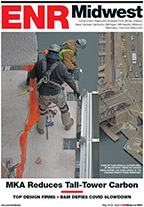Demand for design services dipped for Midwest architects in September but managed to maintain positive growth for a third consecutive month, according to the American Institute of Architects (AIA) Architectural Billing Index (ABI).
After rising to 51.7 in August, the Midwest index retreated to 51 in September. By comparison, the national index, derived from a work-on-boards survey, rose from 53.8 to 54.3 over the same period. According to AIA, any score above 50 denotes increasing demand for design work.
After dipping sharply into negative territory in April, the national index has risen steadily since May. The Midwest index also dipped sharply in the spring, but did not return to positive growth until July. In January, the Midwest index hit its 12-month high with a score of nearly 55.
Growth was also positive across all regions in September, with the West scoring 60.1, the South 54.1, and Northeast 50.7.
By sector, commercial/industrial (57.9) showed the strongest growth in September, followed by multi-family residential (55.6), mixed practice (55.4), institutional (50.4)
“The prolonged economic downturn that has affected the industry has actually resulted in increased productivity levels as reported by architecture firms,” says AIA Chief Economist Kermit Baker. “ In addition to new approaches to business challenges, the utilization of new technologies and a renewed focus on efficiency have architecture firms realizing all-time highs in productivity, and these new efficiencies can greatly benefit clients from a project timeline and budget standpoint.”
As a leading economic indicator of construction activity, the ABI reflects the approximate nine- to 12-month lag time between architectural billings and construction spending



Post a comment to this article
Report Abusive Comment